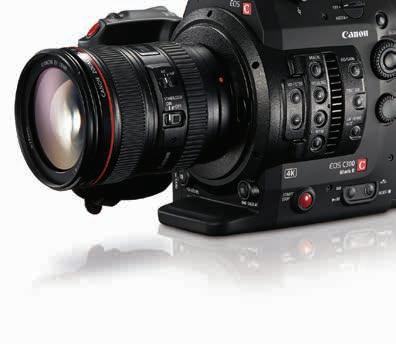
5 minute read
Lighting the Dark
Halloween Special
Micha Dahan csc shoots a scene for Bed of the Dead.
Lighting the Dark
By C. MCRAE, Special to Canadian Cinematographer
Credit: Nick Montgomery T hey are guilty pleasures we don’t like to admit indulging in – horror movies. As a teen, sitting in your best friend’s basement watching Friday the 13th (with the volume down), you’re feigning cool, but you know you’re not sleeping tonight. Why do we delight in these irrational, disturbing, almost psychologically damaging images and themes? There is an innate human fascination with horror. Chris Alexander, writer, critic, director and die-hard horror fan, elaborates: “It’s an exploitation of that basic primal, human fear. We have this perpetually underlying dread and anxiety about death and what lies beyond. Horror movies draw that to the surface and throw it in our face, where we digest it in small bites. It becomes entertainment. It’s akin to bungee jumping to the precipice of death, then we bounce back. Somehow we convince ourselves we have control.” Creating the cinematic content to fulfill this need is an exhilarating, noholds-barred adventure that many filmmakers embark on, and the relationship between director and DP is particularly crucial. George Mihalka (director of the cult classic slasher film My Bloody Valentine) elucidates: “A good horror film is the result of a combination of things, but creating the right mood through the cinematography is paramount. It has to feel credible. Much of this is the result of the cinematographer/director partnership. You have to find that balance. The whole point of horror films
is to bring the audience in, not to keep them at arm’s length, observing from the outside, and it’s the level of understanding between these two key people that makes it work.” Toronto-based Black Fawn Films’ most recent horror release, Bed of the Dead, directed by associate member Jeff Maher and shot by Micha Dahan csc, exemplifies the challenges and rewards of creating compelling visual content on a shoestring budget. “Jeff pitched a film idea about a haunted bed that kills people who had committed sins,” Chad Archibald, Black Fawn Films’ co-owner/executive producer, says. “He wrote a treatment and we came to the next big question: who the hell is going to come in and DP for him? With a first feature, the weight of the world is on your shoulders. It was really important to find someone Jeff could trust behind the camera. [Black Fawn Films’ co-owner] Cody Calahan introduced Jeff to Micha and they immediately hit it off.” Maher explains, “Micha’s work was very interesting to me. Usually I can look at an image and tell you, to a certain extent, what lights may have been used and how they were positioned to achieve the effect, but I couldn’t figure it out with a lot of Micha’s previous work. He has a very organic and experimental style, which I’m a big fan of. I knew I wanted someone who wasn’t scared to try new things but who would also be able to rely on the tried and tested old techniques when the clock was ticking. He’s not there to make pretty pictures for his reel. His only interest is to add visual subtext to the film through lighting and camera movement, which is all that matters to me.” Dahan adds, “Shooting for another DP could have gone either way. Fortunately, Jeff and I rapidly developed the visual language. Among the films we referenced were The Babadook (Radek Ladczuk, DP) and Be Kind, Rewind (Ellen Kuras, DP). On set, we found a shorthand immediately. In fact, at some point, Jeff and I stopped using words and begun to speak in sound effects. Why waste words when we were reading each other’s minds anyway? We must have looked insane. Our resources were limited, so we had to be extremely efficient. We knew right off the bat that we would not have the ability to re-light very often. One radical
MOSS









Still from Bed of the Dead.

Bed of the Dead director associate member Jeff Maher.

decision we made was to paint the set with glossy paint. Unusual, yes, but this allowed us to compose deliberate reflections of established practical lamps into the blue walls. We used 100w peppers with diffusion, dimmed down so that they don’t actually cast any light on the scene, but rather are reflected by the gloss. One can see the texture of the plaster, the brush strokes, the scuffs. All of these details tell an additional story of the room and of the bed.” “It was funny because the majority of the shoot took place in one giant room with nothing to break up the light,” interjects Archibald. “I remember every day I would come in and there would be more pieces of foam core and little things, hanging from the ceiling, on stands, everywhere! It looked absurd, to actually see what they were doing to manipulate this light, but when I looked in the frame it was fantastic!” “We made a bunch of charley bars, with which we’d strategically throw shadows onto the set,” Dahan explains. “Lighting is really about shadows. Our collaboration was a reminder of the naïve passion that drew me to the industry years ago. We were kids with video cameras again. It was less about perfection, and more about the spirit of the process.” In the case of Bed of the Dead, it appears to have worked: the film premiered to a sold-out audience at the Fantasia Film Festival in Montreal in July and will be screened at a number of genre film festivals throughout North America and Europe. In a fickle industry, horror films really put things into perspective. For as long as humans have been communicating through visual art, terrifying, macabre themes have played relevant and culturally important roles in our collective consciousness. We are obviously expressing something that needs to be shared.






